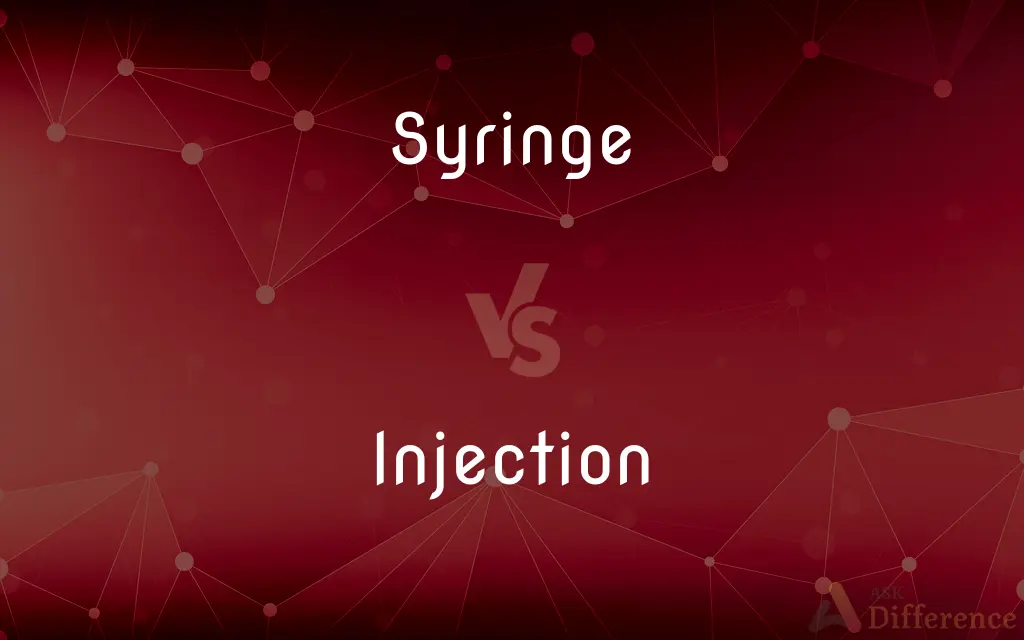Syringe vs. Injection — What's the Difference?
By Fiza Rafique & Urooj Arif — Updated on April 6, 2024
A syringe is a medical device used to inject fluids into or withdraw them from the body, while an injection is the act of administering these fluids using a syringe or similar device.

Difference Between Syringe and Injection
Table of Contents
ADVERTISEMENT
Key Differences
Syringes come in various sizes and types, including insulin syringes, tuberculin syringes, and those equipped with safety features to prevent needle-stick injuries. On the other hand, injections can be classified by their route of administration, such as intravenous (IV), intramuscular (IM), subcutaneous (SC), and more, each chosen based on the medication or vaccine being administered.
The design of the syringe, including the needle gauge and length, is tailored to the specific type of injection, taking into account the viscosity of the medication and the depth at which it needs to be delivered. In contrast, the technique of injection focuses on the location, angle, and depth of penetration to ensure the medication is properly absorbed and effective.
While syringes are a critical tool in the delivery of injections, the practice of administering an injection requires knowledge of anatomy, the medication being used, and the proper technique to minimize discomfort and maximize efficacy. Conversely, understanding the nuances of various syringe types and their appropriate uses is essential for healthcare professionals to execute injections safely and effectively.
Comparison Chart
Definition
A medical device for injecting or withdrawing fluids
The act of administering fluids into the body
Types
Insulin, tuberculin, safety syringes, etc.
Intravenous, intramuscular, subcutaneous, etc.
ADVERTISEMENT
Purpose
To draw in or expel fluids
To deliver medication or vaccines into the body
Key Components
Barrel, plunger, needle
Medication, vaccine, route of administration
Considerations
Size, needle gauge, and length
Location, angle, depth of penetration
Compare with Definitions
Syringe
Insulin Syringe.
A small syringe marked in units of insulin for the precise dosing and administration of insulin to diabetic patients.
Injection
Subcutaneous Injection (SC).
An injection administered into the fat layer beneath the skin, used for vaccines and insulin.
Syringe
A syringe designed with a safety mechanism to prevent needle-stick injuries after use.
After giving the injection, the doctor engaged the safety syringe's needle cover to prevent accidental pricks.
Injection
Vaccination Injection.
The act of introducing a vaccine into the body via a syringe to stimulate the immune system's defense against specific diseases.
Syringe
Tuberculin Syringe.
A syringe used for tuberculosis testing and precise measurement of small volumes of liquid, marked in milliliters.
Injection
Insulin injections are commonly given subcutaneously for steady absorption.
Intramuscular Injection (IM).
Syringe
A device used for injecting or withdrawing fluids from the body, consisting of a needle, barrel, and plunger.
The nurse filled the syringe with vaccine before administering the shot.
Injection
The act of injecting.
Syringe
A syringe is a simple reciprocating pump consisting of a plunger (though in modern syringes, it is actually a piston) that fits tightly within a cylindrical tube called a barrel. The plunger can be linearly pulled and pushed along the inside of the tube, allowing the syringe to take in and expel liquid or gas through a discharge orifice at the front (open) end of the tube.
Injection
Something that is injected, especially a dose of liquid medicine injected into the body.
Syringe
A medical instrument used to inject fluids into the body or draw them from it.
Injection
(Mathematics) A function that is one-to-one.
Syringe
A hypodermic syringe.
Injection
The act of injecting, or something that is injected.
Syringe
A device used for injecting or drawing fluids through a membrane.
Injection
A specimen prepared by injection.
Syringe
A device consisting of a hypodermic needle, a chamber for containing liquids, and a piston for applying pressure (to inject) or reducing pressure (to draw); a hypodermic syringe.
Injection
(category theory) A morphism from either one of the two components of a coproduct to that coproduct.
Syringe
To clean or rinse by means of a syringe.
Have your ears syringed! They're so dirty!
Injection
(construction) The act of inserting materials like concrete grout or gravel by using high pressure pumps.
Syringe
To inject by means of a syringe.
Injection
(figuratively) The supply of additional funding to a person or a business.
The troubled business received a much-needed cash injection.
Syringe
A kind of small hand-pump for throwing a stream of liquid, or for purposes of aspiration. It consists of a small cylindrical barrel and piston, or a bulb of soft elastic material, with or without valves, and with a nozzle which is sometimes at the end of a flexible tube; - used for injecting animal bodies, cleansing wounds, etc.
Injection
(mathematics) A relation on sets (X,Y) that associates each element of Y with at most one element of X. Category:en:Functions
Syringe
To inject by means of a syringe; as, to syringe warm water into a vein.
Injection
(computer security) The insertion of program code into an application, URL, hardware, etc.; especially when malicious or when the target is not designed for such insertion.
A SQL injection exploit allowing a malicious user to modify a database query
Syringe
To wash and clean by injection from a syringe.
Injection
(space) The act of putting a spacecraft into a particular orbit, especially for changing a stable orbit into a transfer orbit, e.g. trans-lunar injection.
Syringe
A medical instrument used to inject or withdraw fluids
Injection
(set theory) A function that maps distinct x in the domain to distinct y in the codomain; formally, a f: X → Y such that f(a) = f(b) implies a = b for any a, b in the domain.
Syringe
Spray or irrigate (a body part) with a syringe
Injection
(medicine) Something injected subcutaneously, intravenously, or intramuscularly by use of a syringe and a needle.
Injection
(internal combustion engines) Fuel injection: the pressurized introduction of fuel into a cylinder.
Direct injection
Tuned port injection
Injection
(steam engines) The act of throwing cold water into a condenser to produce a vacuum.
Injection
(steam engines) The cold water thrown into a condenser to produce a vacuum.
Injection
The act of injecting or throwing in; - applied particularly to the forcible insertion of a liquid or gas, by means of a syringe, pump, etc.
Injection
That which is injected; especially, a liquid inserted thrown into a cavity of the body by a syringe or pipe; a clyster; an enema.
Injection
The act or process of filling vessels, cavities, or tissues with a fluid or other substance.
Injection
The act of throwing cold water into a condenser to produce a vacuum.
Injection
The forceful insertion of a substance under pressure
Injection
Any solution that is injected (as into the skin)
Injection
The act of putting a liquid into the body by means of a syringe;
The nurse gave him a flu shot
Common Curiosities
What are the types of injections?
Common types include intravenous (IV), intramuscular (IM), and subcutaneous (SC), each involving different layers of the body.
What is an injection?
An injection is the process of administering medication, vaccines, or other substances into the body through the skin using a syringe or similar device.
How do syringe sizes vary?
Syringe sizes vary by volume, typically measured in milliliters or cubic centimeters, to accommodate different doses of medication.
Why are there different needle gauges for syringes?
Different gauges (thicknesses) are used based on the viscosity of the fluid being injected and the desired penetration depth.
What training is required to administer injections?
Healthcare professionals receive training on anatomy, injection techniques, and safety protocols to administer injections effectively and safely.
What is a syringe?
A syringe is a medical device used to inject substances into or withdraw them from the body, consisting of a needle, barrel, and plunger.
How do injections help with vaccinations?
Injections allow vaccines to be delivered directly into the body, stimulating an immune response to protect against diseases.
Why is the angle of injection important?
The angle helps ensure the medication is delivered to the correct tissue layer, affecting absorption and efficacy.
What is the purpose of a safety syringe?
Safety syringes are designed to prevent needle-stick injuries, featuring mechanisms that cover or retract the needle after use.
Can syringes be reused?
For personal medical conditions like diabetes, syringes can sometimes be reused by a single individual, but generally, to prevent contamination and infections, single use is recommended.
Can all medications be administered by injection?
Not all medications are suitable for injection; the method of administration depends on the drug's formulation and intended effect.
How do environmental factors affect syringe storage?
Syringes should be stored in a clean, dry place and sometimes under specific temperature conditions to maintain sterility and integrity.
Are there non-needle methods for injections?
Yes, there are needle-free injection technologies that use high pressure to deliver medication through the skin.
How is the correct injection site determined?
The injection site is determined based on the type of injection and the medication being administered, considering the target tissue and absorption rate.
What complications can arise from injections?
Complications can include infections, nerve damage, or allergic reactions, emphasizing the need for proper technique and equipment.
Share Your Discovery

Previous Comparison
Punjabi vs. Gujarati
Next Comparison
Potential vs. PerformanceAuthor Spotlight
Written by
Fiza RafiqueFiza Rafique is a skilled content writer at AskDifference.com, where she meticulously refines and enhances written pieces. Drawing from her vast editorial expertise, Fiza ensures clarity, accuracy, and precision in every article. Passionate about language, she continually seeks to elevate the quality of content for readers worldwide.
Co-written by
Urooj ArifUrooj is a skilled content writer at Ask Difference, known for her exceptional ability to simplify complex topics into engaging and informative content. With a passion for research and a flair for clear, concise writing, she consistently delivers articles that resonate with our diverse audience.
















































